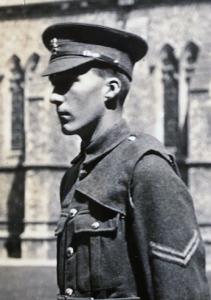
|

|
| Lieutenant (E) Osmond Peter TILDEN RN | |
|
HMS Duchess Royal Navy Date of birth: 8th March 1909 Date of death: 12th December 1939 Killed in action aged 30 Commemorated on the Chatham Naval Memorial 33.1 |

|
| Osmond Peter Tilden was born at Epsom in Surrey on the 8th March 1909 the son of Harry Tilden, Secretary of the Bank of England, and Ada (nee Osmond) Tilden of “Selma”, 6 Ashdown Road, Epsom in Surrey. He was educated at Lancing College where he was in Olds House from January 1923 to December 1926. He gained his School Certificate in 1926 and was a member of the Officer Training Corps where he rose to the rank of Sergeant and achieved Certificate A in 1926. In January 1927 he entered the Royal Navy as a special entry Cadet at HMS Erebus. He was appointed as a Midshipman in 1928 and went on to the Royal Naval Engineering College at Keyham for a four year course. He was promoted to Sub Lieutenant on the 1st of June 1930 and to Lieutenant on the 1st of October 1932 at which time he served in home waters with the light cruiser HMS Champion and with the heavy cruiser HMS Exeter. He served with the light cruiser HMS Dauntless in the Mediterranean and with the battleship HMS Royal Sovereign part of the Home Fleet. He was married at Devonport in 1931 to Sophia Hilda (nee Ife), of Devonport, Devon. After the war she was remarried to George R. Hunter. For two years from April 1937 he was on the staff of the Mechanical Training Establishment at Chatham. He was later posted to the destroyer HMS Duchess (H64) as Engineering Officer. Just before the outbreak of war HMS Duchess was on the China Station and received orders to join the Mediterranean Fleet before receiving orders to return home as an escort. On the 12th of December 1939 HMS Duchess, under the command of Lieutenant Commander Robert Charles Meadows White RN, was arriving at the River Clyde along with two other destroyers as escort to the battleship HMS Barham. The convoy was in total darkness and the crews were inexperienced in wartime conditions. At 4.27am the destroyer was nine miles off the Mull of Kintyre and was zigzagging in fog when she collided with HMS Barham, cutting HMS Duchess in half and she overturned, trapping many of the crew including Captain Meadows. As she sank the depth charges in the aft end of the ship, which had been primed for action, exploded as they sank causing many casualties. Seaman Frank Loy RN on board HMS Barham witnessed the carnage: - "There were terrible scenes as "Barham" lost way and rescue attempts were made. Sea boats were turned inboard, hampering life saving operations. Men screamed as they drowned in the cold waters, choked by spreading oil fuel. In these early days of the war no escape ports were provided in ships' sides and the capsized forward half of the destroyer presented stark horror as men screamed through the small scuttles as they passed astern to their deaths. "Barham" struck "Duchess" between the forward funnel and the galley flat. Depth charges, not set to "Safe" exploded in the after part of "Duchess" adding to the night's carnage. A young Midshipman and Leading Seaman Charlie Bishop both dived into the icy cold water to rescue several men; they were the heroes of the night. Other "Duchess" men survived by walking down their ship's side and stepping onto the side of "Barham" by the 6 inch starboard battery. It took until we reached Greenock to clean off the oil from the survivors whom we had plied with hot drinks liberally laced with rum." She sank with the loss of six officers and one hundred and twenty three ratings with only one officer and twenty two ratings surviving. His brother, Commander Eric Henry Tilden DSC RN HMS Firedrake, Royal Navy, was killed in action on the 17th of December 1942. He is commemorated on the war memorial at Epsom. |
|
| Olds House |
Back